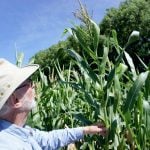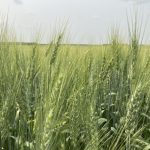1.
Tag Archives Silage

45 years of breeding better silage
Independent corn breeder Francis Glenn reflects on corn silage genetics, industry consolidation, and opportunity
Independent Ontario corn breeder Francis Glenn reflects on corn silage genetics, industry consolidation, and opportunity.

Rain aids some Saskatchewan crops
Soil moisture largely adequate
There was some relief for crops in Saskatchewan following sporadic showers. The provincial agriculture department said farmers are hoping for more rain to aid head and pod filling, but the weekly crop report for the week ended July 28 noted that more moisture wouldn’t help the yields for more advanced crops.

John Deere debuts updated F8 and F9 forage harvesters
New machines offer upgraded features and more ponies
John Deere has updated its F8 and F9 forage harvester models. The models have increased horsepower options, expanded automation features and technology offerings compared to previous models.

VIDEO: New tool helps prevent spoilage in silage
Just 'Face-it'. It's a good idea to maintain your silage pile
It’s always fun to see new products at the Canada’s Outdoor Farm Show site, especially when their inventor is on-hand to talk about them. In this case, it was Eli […] Read more

Enogen corn touted for silage feed efficiency
Ruminant nutrition team helps Syngenta promote new hybrids
In just one full growing season of its Canadian introduction, the Syngenta crop input company's Enogen line of corn hybrids has made serious inroads in the Ontario marketplace.

Corteva showcases new BMR silage varieties at Canada’s Outdoor Farm Show 2024
Corteva Agrisciences is showcasing its new Boltava brand of brown mid-rib silage corn hybrids at Canada's Outdoor Farm Show near Woodstock.

Corteva showcases new BMR silage varieties at Canada’s Outdoor Farm Show 2024
Corteva Agrisciences is showcasing its new Boltava brand of brown mid-rib silage corn hybrids at Canada's Outdoor Farm Show near Woodstock.

Reducing dairy methane starts with feed
AAFC researcher reviews what farmers can do to mitigate methane
Feeding strategies can play an important role in helping dairy farmers in Canada achieve the goal of becoming carbon neutral by 2050, a target set by the Dairy Farmers of […] Read more

Charting the return of silage hybrids
Many producers want a broader range of attributes for corn
When assessing value in a corn crop, producers’ needs vary according to end uses. For cash croppers, it is measured in yield and bushels, but livestock producers want greater digestibility […] Read more

Silage growers urged to protect feed supply from Bt-resistant corn rootworm
Pest has caused significant yield loss in both Canada and the U.S.
Some livestock producers in the U.S. corn belt have had to make a difficult and costly decision. They’ve harvested their silage corn for grain to salvage some financial return. Now […] Read more


